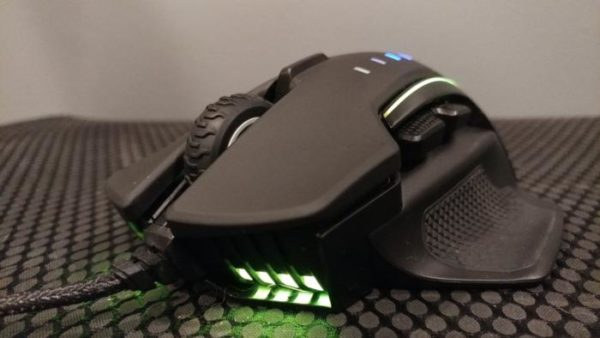The Corsair Glaive is the reason I spend weeks with every mouse we review. Usually the extra time feels like a formality—I can tell almost instantly whether or not I like a mouse. But every once in a while there’s a Glaive, a mouse I strongly disliked at first but (somewhat) reversed opinion on over time.
This review is part of our roundup of best gaming mice. Go there for details on competing products and how we tested them.
The design: A rodent linebacker
What’s funny is the Glaive ($60 on Amazon) looks like a pretty generic mouse. You wouldn’t think it would take so long to adjust to it, judging from pictures.
Test drive one in person though, and you’ll immediately realize how hard it is to judge scale from product photos. The Glaive is large. Or rather, broad. With the default thumb-piece attached (more on that later) it measures 2.9 inches across. With the wider thumb-rest, it’s 3.6 inches.
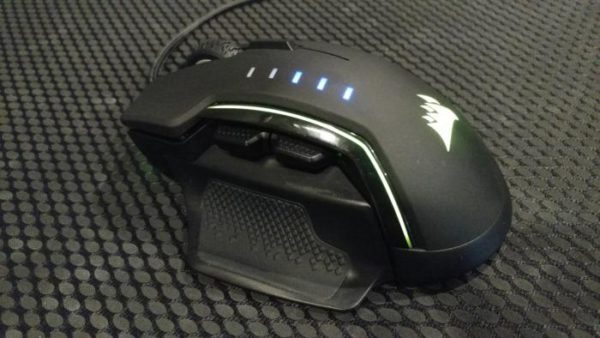
IDG / Hayden Dingman
Numbers only tell part of the story. If you compare those measurements to other mice like the Logitech G502 (2.9 inches) or the Razer DeathAdder (2.8 inches), the Glaive doesn’t seem that hefty.
The difference is that the G502 and DeathAdder are tapered. Measure them at their widest point and you get the numbers above, but each narrows considerably as it approaches your wrist, and usually features a considerable cutout for your ring/pinky fingers along the side, too. The G502 hits 2.9 inches with the thumb rest included, for instance.
The Glaive is almost rectangular by comparison. It’s wide at the top, it’s wide at the bottom, it’s wide in between. The domed top masks this fact a bit, and it certainly doesn’t look like (for instance) 1984’s actually-rectangular Macintosh mouse. Still, this is a mouse with a broad set of shoulders. It also makes it a bit difficult to lift and reposition, especially with the Glaive weighing in at 4.3 ounces.
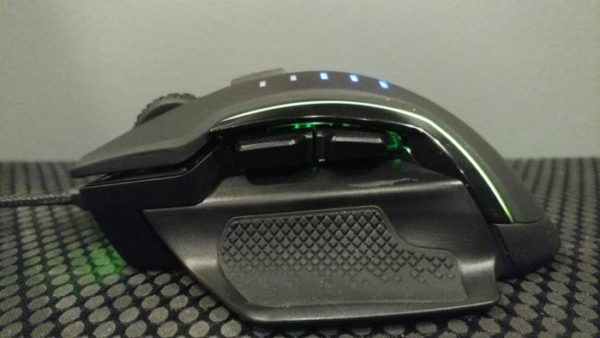
IDG / Hayden Dingman
There are other oddities too. The thumb buttons, for instance. Most mice try to make the thumb buttons as inconspicuous as possible, placing them where (it’s expected) you’d grip, then contouring them so they lie almost flush with the chassis.
Here? Not so much. The Glaive has three removable side panels. One, the default, slopes under the mouse and gives the Glaive a somewhat DeathAdder-like shape. The second, which is textured for better grip, slopes out slightly, adding another half-inch or so to the already-broad Glaive. The third option, also textured, adds a G502-style thumb rest.
These panels are magnetic and thus easily swapped out. I’ve personally been using the thumb-rest option, which while admittedly wide, is both comfortable and adds another mouse skate to the bottom of the Glaive.
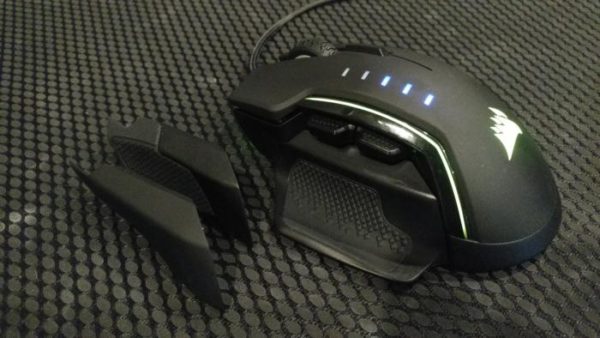
IDG / Hayden Dingman
Getting back to the odd part, though: No matter which option you choose, the thumb buttons aren’t contoured to the side panel. There’s about a quarter-inch gap between the top of each panel and the actual thumb buttons.
It’s an incredibly weird design, and another reason I didn’t like the Glaive at first. It seemed like no matter how I held it, I couldn’t find a grip that was both comfortable and left my fingers on the thumb buttons. Even after a week I was still adjusting.
And then, sometime in the second week, it clicked. I found myself not really noticing the Glaive’s shape as much, my hand unconsciously adopting some sort of hybrid claw/palm grip that I’d settled on as the most comfortable option. Likewise, my thumb adjusted to the groove, using it for extra friction and support while resting on the thumb buttons.
Is it my favorite design? Absolutely not. It lacks both the familiarity of a more traditional mouse and the comfort of a unconventional (and overlarge) built-for-ergonomics design like the Mionix Naos.
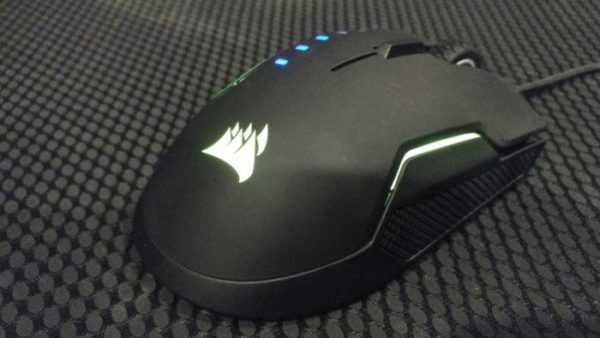
IDG / Hayden Dingman
The Glaive did grow on me, though. I also think it would be a great choice for people with wide hands—who don’t have many options in that category, generally. The Naos is a good one, as are a few of Logitech’s non-gaming designs, but if you find the average mouse disappearing in your hands the Glaive might be worth a second look.
Some other notes before we wrap up:
1) Like every other gaming mouse nowadays, the Glaive is festooned with RGB LED zones. Three, to be exact—a ribbon on each side, two “headlights” on the front, and Corsair’s logo under the palm. There are also five blue (non-RGB) lights to delineate DPI, arrayed basically where your index finger stretches down to the left mouse button. The latter is especially attractive, and actually one of my favorite elements on the Glaive.
The power draw must be higher than most RGB mice though, reason being that the Glaive gets warm after extended use—particularly under those DPI lights. It’s a pretty faint heat, and certainly not dangerous, but it’s…unnerving?
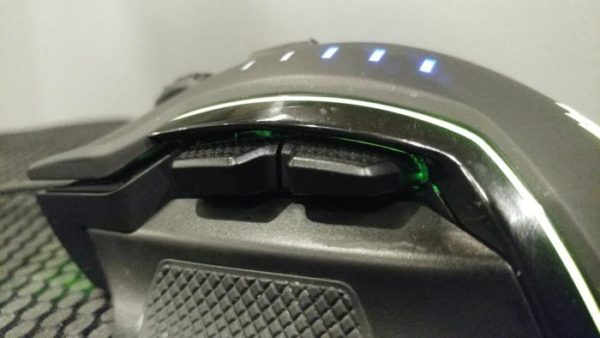
IDG / Hayden Dingman
2) With five programmable DPI settings, the Glaive really needs two buttons to switch up/down instead of single DPI cycler. It’s ludicrous to accidentally tap the DPI button, then have to tap it four more times to get back to your preferred setting. Almost unusable.
Left-click is a bit stiff, too. It’s gotten better the longer I’ve used it, but constant double-clicking is a bit harder here than it is on most other mice nowadays.
3) The sensor is great, but Corsair’s default settings are not. The Glaive uses a PMW 3367, which would seem to be Corsair’s custom take on the now-standard 3360/3366. The main difference is the 3360/3366 tops out at 12,000 DPI, the 3367 at 16,000. Those high-end numbers are largely pointless though, and at lower sensitivities the 3360/3366 and 3367 perform pretty similarly.
The Glaive defaults in Corsair’s software to a “Medium” liftoff distance though—the amount you have to raise the mouse before it stops registering. This is a no-go for anyone who constantly lifts and adjusts while gaming, and means you’re practically required to install Corsair’s software if only to toggle this setting to “Low,” which gives a proper 1-ish millimeter liftoff and prevents erroneous mouse movement when repositioning.
Bottom line
Like I said, if you have large hands, the Glaive should be high on your list. That market is under-served, especially in gaming circles, and aside from the aforementioned Mionix Naos, the Glaive is probably your most comfortable option. It’s a surprisingly comfortable mouse, once you adjust to it.
But it’s a weird design, and I think Corsair should do a second pass on some aspects. The right edge could stand to be a bit more sculpted—that’s where most of the “broad” feeling comes from—and the thumb groove minimized. Also, if it’s a choice between “Lots of RGBs” and “A mouse that doesn’t heat up so much it makes my palm sweat,” I’ll take the latter. Always.
[Note: There are also a non-zero number of reviews on Amazon/Newegg talking about click issues—specifically single clicks registering as doubles. I didn’t have this issue in my review unit over a few weeks of use and thus didn’t factor it into the score, but it’s something to be aware of.]



